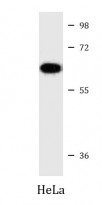ARG57489
anti-NR1D2 antibody
anti-NR1D2 antibody for Western blot and Human
概述
| 产品描述 | Rabbit Polyclonal antibody recognizes NR1D2 |
|---|---|
| 反应物种 | Hu |
| 应用 | WB |
| 宿主 | Rabbit |
| 克隆 | Polyclonal |
| 同位型 | IgG |
| 靶点名称 | NR1D2 |
| 抗原物种 | Human |
| 抗原 | KLH-conjugated synthetic peptide corresponding to aa. 266-294 (Center) of Human NR1D2. |
| 偶联标记 | Un-conjugated |
| 別名 | BD73; V-erbA-related protein 1-related; Orphan nuclear hormone receptor BD73; Rev-erb alpha-related receptor; EAR-1R; Rev-erb-beta; RVR; Nuclear receptor subfamily 1 group D member 2 |
应用说明
| 应用建议 |
|
||||
|---|---|---|---|---|---|
| 应用说明 | * The dilutions indicate recommended starting dilutions and the optimal dilutions or concentrations should be determined by the scientist. | ||||
| 阳性对照 | HeLa |
属性
| 形式 | Liquid |
|---|---|
| 纯化 | Purification with Protein A and immunogen peptide. |
| 缓冲液 | PBS and 0.09% (W/V) Sodium azide. |
| 抗菌剂 | 0.09% (W/V) Sodium azide. |
| 存放说明 | For continuous use, store undiluted antibody at 2-8°C for up to a week. For long-term storage, aliquot and store at -20°C or below. Storage in frost free freezers is not recommended. Avoid repeated freeze/thaw cycles. Suggest spin the vial prior to opening. The antibody solution should be gently mixed before use. |
| 注意事项 | For laboratory research only, not for drug, diagnostic or other use. |
生物信息
| 数据库连接 |
Swiss-port # Q14995 Human Nuclear receptor subfamily 1 group D member 2 |
|---|---|
| 基因名称 | NR1D2 |
| 全名 | nuclear receptor subfamily 1, group D, member 2 |
| 背景介绍 | This gene encodes a member of the nuclear hormone receptor family, specifically the NR1 subfamily of receptors. The encoded protein functions as a transcriptional repressor and may play a role in circadian rhythms and carbohydrate and lipid metabolism. Alternatively spliced transcript variants have been described. [provided by RefSeq, Feb 2009] |
| 生物功能 | Transcriptional repressor which coordinates circadian rhythm and metabolic pathways in a heme-dependent manner. Integral component of the complex transcription machinery that governs circadian rhythmicity and forms a critical negative limb of the circadian clock by directly repressing the expression of core clock components ARNTL/BMAL1 and CLOCK. Also regulates genes involved in metabolic functions, including lipid metabolism and the inflammatory response. Acts as a receptor for heme which stimulates its interaction with the NCOR1/HDAC3 corepressor complex, enhancing transcriptional repression. Recognizes two classes of DNA response elements within the promoter of its target genes and can bind to DNA as either monomers or homodimers, depending on the nature of the response element. Binds as a monomer to a response element composed of the consensus half-site motif 5'-[A/G]GGTCA-3' preceded by an A/T-rich 5' sequence (RevRE), or as a homodimer to a direct repeat of the core motif spaced by two nuclegotides (RevDR-2). Acts as a potent competitive repressor of ROR alpha (RORA) function and also negatively regulates the expression of NR1D1. Regulates lipid and energy homeostasis in the skeletal muscle via repression of genes involved in lipid metabolism and myogenesis including: CD36, FABP3, FABP4, UCP3, SCD1 and MSTN. Regulates hepatic lipid metabolism via the repression of APOC3. Represses gene expression at a distance in macrophages by inhibiting the transcription of enhancer-derived RNAs (eRNAs). In addition to its activity as a repressor, can also act as a transcriptional activator. Acts as a transcriptional activator of the sterol regulatory element-binding protein 1 (SREBF1) and the inflammatory mediator interleukin-6 (IL6) in the skeletal muscle. [UniProt] |
| 细胞定位 | Nucleus. |
| 预测分子量 | 65 kDa |
| 翻译后修饰 | Deacetylated by HDAC1. Acetylation and deacetylation regulate its transcriptional regulatory activity. Under more reducing intracellular redox conditions, Cys-384 is in its heme-bound state, which is optimal for recruitment of the NCOR1/HDAC3 corepressor complex and repression of target genes. When subjected to oxidative stress conditions, Cys-384 undergoes oxidation to form a disulfide bridge with Cys-374, also triggering a ligand switch that results in release of bound heme and derepression of target genes. |
检测图片 (1) Click the Picture to Zoom In






